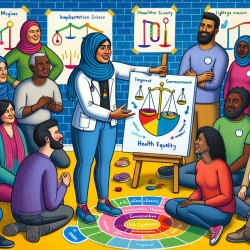Introduction
In the field of speech-language pathology, we are committed to leveraging data-driven insights to foster positive developmental outcomes for children. A recent study titled "Differential relationships of family drinking with alcohol expectancy among urban school children" provides valuable insights into how family drinking behaviors can shape children's expectations about alcohol. This blog post will delve into the key findings of this research and discuss how practitioners can apply these insights to improve prevention programs and encourage further research.
Understanding the Research
The study, conducted in an urban region of Taiwan, surveyed 4th and 6th graders to assess their alcohol expectancy and the influence of family drinking behaviors. The research revealed that family drinking, particularly paternal drinking, significantly impacts children's positive alcohol expectancy. This expectancy is categorized into dimensions such as "enhanced social behaviors," "promoting relaxation," and "global positive transformation."
Interestingly, the study found that children who have not yet consumed alcohol (alcohol-naïve) showed a strong correlation between paternal drinking and positive alcohol expectancy. Conversely, for children who had already tried alcohol, maternal drinking played a more significant role in shaping their expectations.
Implications for Practitioners
As practitioners, understanding these dynamics is crucial for designing effective prevention programs. Here are some strategies to consider:
- Tailored Interventions: Develop interventions that address the specific family dynamics influencing a child's alcohol expectancy. For instance, programs targeting alcohol-naïve children might focus on paternal influences, while those for children who have tried alcohol could emphasize maternal influences.
- Family-Centric Approaches: Encourage family involvement in prevention programs. Educating parents about the impact of their drinking behaviors on their children's expectations can be a powerful tool for change.
- Dimension-Specific Strategies: Recognize that different dimensions of alcohol expectancy (e.g., social behaviors vs. relaxation) may require unique approaches. Tailor your strategies to address these specific dimensions.
Encouraging Further Research
While this study provides valuable insights, it also highlights the need for further research. Here are some areas where additional investigation could be beneficial:
- Cultural Contexts: Explore how cultural differences influence family drinking behaviors and children's alcohol expectancy. This could help tailor prevention programs to diverse populations.
- Longitudinal Studies: Conduct long-term studies to understand how family influences on alcohol expectancy evolve over time and impact future drinking behaviors.
- Broader Family Dynamics: Investigate the role of siblings and extended family members in shaping children's alcohol expectancy.
Conclusion
The research on family drinking and alcohol expectancy among children underscores the importance of data-driven, family-focused strategies in prevention programs. By understanding and addressing the specific family influences on children's alcohol expectancy, practitioners can make a meaningful impact on delaying or preventing early alcohol use. To explore the original research paper, please follow this link: Differential relationships of family drinking with alcohol expectancy among urban school children.










